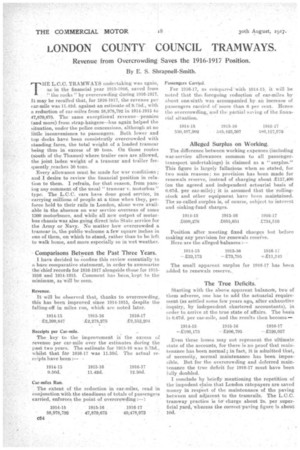LONDON COUNTY COUNCIL TRAMWAYS.
Page 18

If you've noticed an error in this article please click here to report it so we can fix it.
Revenue from Overcrowding Saves the 1916-1917 Position. By E. S. Shrapnell-Smith.
THE L.C.C. TRAMWAYS undertaking was again, ..9in the financial year 1915-1916, saved from ." the rocks " by overcrowding during 1916-1917. It may be recalled that, for 1916-1917, the revenue per car-mile was 11.42d. against an estimate of 9.75d., with a reduction of car-miles from 58,978,792 in 1914-1915 to 47,879,675. The same exceptional revenue—pennies (and more) from strap-hangers—has again helped the situation, under the police concessions, although at no little inconvenience to passengers. Both lower and top decks have been consistently overcrowded with standing fares, the total weight of a loaded tramcar being thus in excess of 20 tons. On those routes (south of the Thames) where trailer cars are allowed, the joint laden weight of a tramcar and tra..iler frequently,reaches 30 tons.
Every allowance must be made for war conditions ; and I desire to review the financial position in relation to them. I refrain, for that reason, from passing any comment of the usual "tramcar v. motorbus" type. The L.C.C. cars have done good service, in carrying millions of people at a time when they, perforce held to their rails in London, alone were available in the absence on war service overseas of some 1300 motorbuses, and while all new output of motorbus chassis was also going direct into State service for the Army or Navy. No matter how overcrowded a tramcar is, the public welcome a few square inches in one of them, on which -to stand, rather than to be left to walk home,, and more especially so in wet weather.
Comparisons Between the Past Three Years. ..
I have decided to confine this review essentially to a bare comparative statement, in order to summarize the-chief records for 1916-1917 alongside those for 19151516 and 1914-1915. Comment has heen,kept to the minimum, as will he seen.
Revenue..
It will be observed that, thanks to overcrowding, this has been improved since 1914-1915, despite the falling-off in miles run, which are noted later.
1914-15 1915-16 1916-1/ • 22,399,847 22,278,275 X2,552,204. • Receipts per Car-mile.
The key to the improvement is the excess of revenue per car-mile over the estimates during. the past two years. The estimate for 19,15-16 was whilst that ferr 1916-17 was 11.50d. The actual receipts have been:—
1914-15 1915-16 1916-17 9.50d. 11.42d. 12,36d.
Car-miles Run.
The extent of the reduction in car-miles, read in conjunction with the steadiness of totals of passengers carried, enforces the point of overcrowding 1914-15 1915-16 1916-17 58,975,792 4'7,879,675 49,478,973 CM Passengers Carriyd.
For 1916-17, as coinpared .with 1914-15, it will be noted that the, foregoing reduction of car-miles by nbout one-sixth was accompanied Jay an increase of passengers carried of 'More than 6 per cent. Hence the overcrowding, and the partial saving of the financial situation.
1914-15 1015-16 1916-17 550,497,992 545,423,397 586,127,076
Alleged Surplus on Working.
The difference between working expenses (including war-service allowances common to all passengertransport undertakings) is claimed as a "surplus." This figure is largely fallacious when so stated, for two Main reasons : no provision has been made for renewals reserve, instead of charging about £137,400. (on the agreed and independent actuarial basis of 0.67d. per car-mile); it is assumed that the 'rollingstock and other equipment have been maintained. The so-called urplu$ is, of course, subject to interest and sinking-fund charges.
1914-15 1915-16 . 1916-17 2099,276 2655,631 2734,510
Position after meeting fixed charges but before snaking any provision for renewals reserve. Here are the alleged balances :-
1914-15 1915-16 1916-17 –X33,173 –273,795 4-211,243
The small apparent surplus for 1916-17 has been added to renewals reserve.
The True Deficits.
Starting with the above apparent balance, two of them adverse, one has to add the actuarial requirement (as settled some few years ago, after exhaustive inquiry, by independent chartered accountants), in order to arrive at the true state of affairs. The basis is 0.67d. per car-mile, and the results then become
1914-15 1915-16 -1916-17 –2196,173 –2206,795 –X126,057 Even these losses may not represent the ultimate state of the accounts, for there is no proof that maintenance has been normal; in fact, it is admitted that, of necessity, normal maintenance has been impossible. But for the overcrowding and deferred maintenance the true deficit for 1916-17 must have been fully doubled.
I conclude by briefly mentioning the repetition of the impudent claim that London ratepayers are saved money in respect of the maintenance of the paving between and adjacent to the tramrails. The L.C.C. tramway practice is to charge about 2s. per superficial yard, Whereas the correct-paving figure is about
10d. •






















